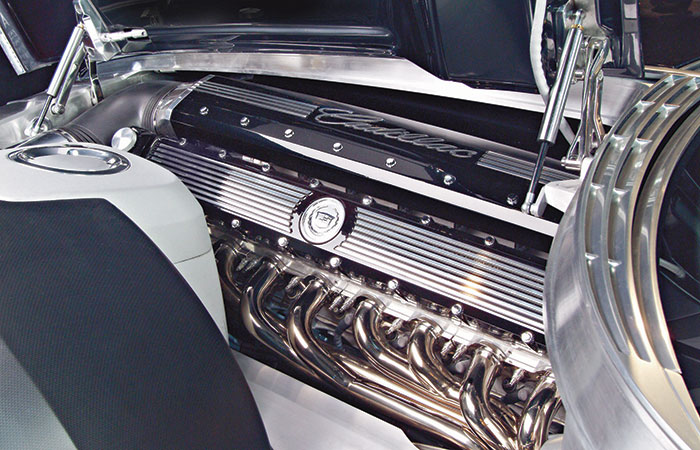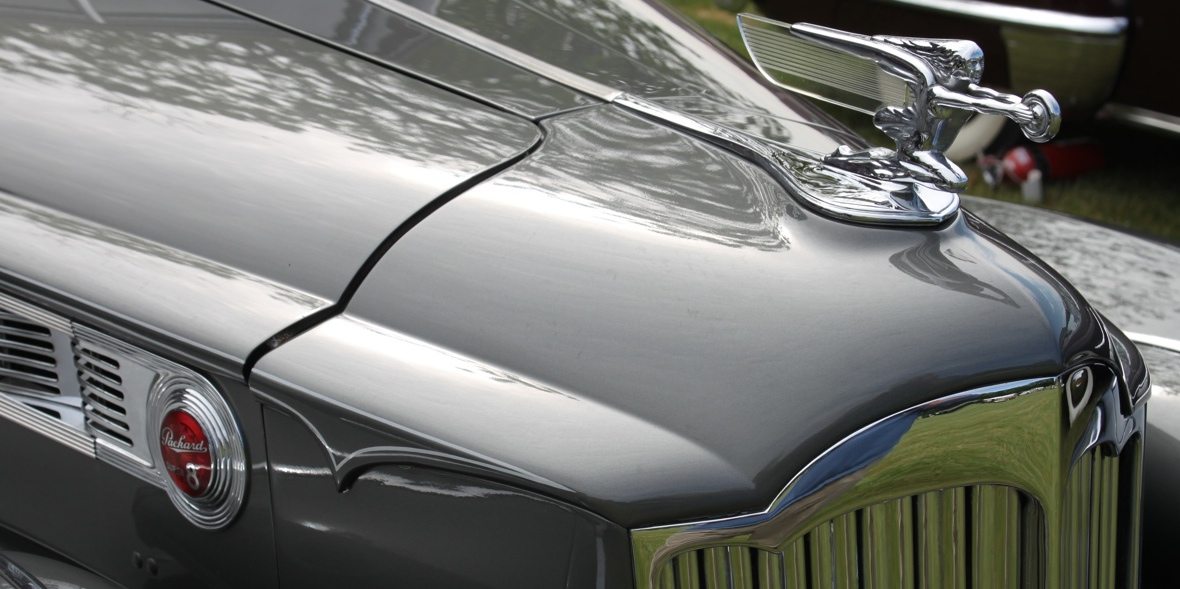
For the better part of the 1900s the four-cylinder engine ruled the road, and then the big sixes arrived with mammoth cubic inch displacements and cylinders nearly the size of paint cans, and for a brief time, it seemed that no greater production engine could be built. But Cadillac quickly dispelled that belief in 1915 with the introduction of a V8. Although there had been eight-cylinder engines developed nearly a decade before Cadillac’s, the public announcement of a production car powered by a 90 degree V8 took the American automotive industry totally by surprise. In one bold stroke the Cadillac Motor Car Company had leveled the playing field, and the competition. After that the gloves were off.

Cadillac may have established itself as the “Standard of the World” but over on East Grand Boulevard, Packard was setting the standard. No sooner had Cadillac brought out its V8 than the Packard Motor Company and its chief engineer, Col. Jesse Vincent, fired the first salvo in what was to become the cylinder wars. In 1915, the men of Packard introduced the Twin Six, the first 12-cylinder automobile put into series production anywhere in the world. At the time of its debut, on May 1, 1915, the Twin Six marked the greatest single advance in automotive design and engineering since the introduction of the Mercedes in 1901.


Often referred to as the “Rolls-Royce of America,” Packard’s mighty V12s dominated the American automotive industry from 1915 until they were discontinued in 1923. No other model in the company’s history did more to establish the Packard name than the Twin Six. After the Packard eight replaced the Twin-Six, V8s and straight eights became the dominant engine designs throughout the late 1920s, and it seemed that eight was enough. But that really wasn’t the case, at least at Cadillac and Marmon, who were both in a race to develop America’s first V16 engine. Cadillac won. On January 4, 1930, at the annual New York Automobile Show, held at the fashionable Waldorf Astoria Hotel, the General Motors luxury car division unveiled the V16 to an astounded crowd of spectators and journalists. Marmon, unfortunately, would need until November 1930 before introducing their V16 at the Chicago Automobile Show. Despite the fact that the Marmon V16 was a larger displacement, nearly 500 cubic inches, offered 200 horsepower, and was at least 10mph faster than the Cadillac V16, the GM division had already taken the market by storm, and in January 1931, stunned the automotive world a second time with the addition of a new V12 engine; thus, stealing Marmon’s thunder for a second time. The Indianapolis, Indiana, automaker was never able to win a significant share of the luxury car market with its Sixteen, the only model left in the Marmon line when the company went into receivership in 1934.

As the decade wore on and the “stock market correction of 1929” turned into the Great Depression of the 1930s, most automakers turned conservative. Cadillac, however, had already committed itself to its aggressive new model lines. Although sales were brisk for the first year, with 3,251 deliveries of the V16, after that they began to dwindle. Even so, Cadillac had the new V12 and an exceptional lineup of V8 models to help maintain its share of new car sales throughout the Depression. Even when it appeared that Cadillac had thrown in the towel, discontinuing the V16 and V12 after 1937, the following year the company came back with a new L-head sixteen, which remained in production through 1941.

Despite the economic turmoil in America, throughout the 1930s the multi-cylinder wars had raged on. Packard, Lincoln, Auburn, Pierce-Arrow and Franklin all introduced 12-cylinder engines, the latter an unprecedented air-cooled V12. Packard had dusted off the Twin-Six name in 1932 to introduce a new V12 model, which became the highly successful Packard Twelve, sold from 1933 through 1938. Auburn introduced its V12 in 1932, and continued to offer 12-cylinder models until 1934. Franklin’s venture into the cylinder wars was very brief, beginning late in 1932 with the debut of its air-cooled, 150-horsepower, 6.8-liter, supercharged V12. The cars were only produced through 1934, when Herbert Franklin was forced to close the doors to his Syracuse, New York, company after 32 years in business. Pierce-Arrow, another New York-based automaker, was among the Nation’s leading luxury marques in the 1910s and 1920s, expanding into the highly competitive 12-cylinder market in 1931 and continuing up until that company was also forced to cease operations in 1938.


Outside of Cadillac and Packard, the only other American automaker building a V12 that survived beyond the 1930s was Lincoln, which added the Model KB to the line in 1932, and the companion Model KA in 1933. In 1935, the twelve was reduced to one series, the Model K, and joined by the 12-cylinder Lincoln-Zephyr in 1936. The Model K remained in production through 1941 and the Continental model joined the Zephyr in 1940. Both continued to be built, along with the Custom Twelve, introduced for the 1942 model year, until civilian automobile production was suspended in February 1942. The Continental was reprised in 1946, and remained in production until 1948, making Lincoln the winner of the cylinder wars in America…if you follow the “last man standing” theory.

In Europe, Hispano-Suiza had introduced the 200-horsepower J12 model in 1931, but only 100 were built between 1931 and 1937. Rolls-Royce, still with only an inline six in the Phantom II, realized that their cars were simply no match on either continent. Thus, in the fall of 1935, the great British automaker cast its lot into the fray with the 12-cylinder Phantom III. This was an entirely new Phantom, from the 142-inch wheelbase chassis and General Motors-type independent front suspension, to the massive overhead valve V12 engine displacing 447.9 cubic inches. The Rolls-Royce Twelve delivered up to 180 horsepower at 3000 rpm and could easily take a full-bodied town car to 85mph. Later models with overdrive were capable of nearly 100mph in top gear, making this the fastest, and thanks to the improved suspension, best handling Phantom ever built. It was also to be the least produced prewar model, with total deliveries ending at the 710th chassis in 1939.

In 1929, the same year that the Graf Zeppelin circled the world in 448 hours, powered by five 550-horsepower Maybach V12 engines, Maybach introduced the company’s first V12 automobile, a car intended to out class the finest Mercedes-Benz and compete in the luxury market against such lofty makes as Rolls-Royce and Hispano-Suiza. In 1930, Maybach introduced the improved 150-horsepower, 7-liter, 60-degree V12 DS 7 (Double Six Cylinders, Seven Liters) Zeppelin model. The next year an even more powerful 8-liter version was introduced delivering a robust 200-horsepower.

The luxuriant Maybach Zeppelin DS 8 was far more elegant than the Mercedes-Benz 770. It was also substantially larger. Because of its weight, more than three tons, a Maybach DS 8 owner had to carry a truck driver’s license! In Germany, general driver’s licenses only permitted curb weights of up to two and a half tons. Yet, despite its massive size, the Maybach was capable of attaining 100mph. The bare chassis in U.S. dollars commanded a price in 1934 of $8,000—just slightly less than a Model J Duesenberg chassis. Maybach chassis were available in two wheelbase lengths, 144 inches and 147 inches, the former being discontinued in 1937. The DS 8 line was produced though 1940, endowing Maybach with a reputation that ultimately came closer to that of Rolls-Royce than Mercedes-Benz. The Maybach Zeppelins came to be regarded as one of Germany’s leading high status luxury cars.
After World War II, the company briefly entertained the idea of building automobiles once again. In 1960, Maybach was acquired by Daimler-Benz and evolved into what is today MTU in the DaimlerChrysler portfolio of transportation companies.
Horch, one of the four rings comprising the original German Auto Union, introduced a 12-cylinder model shortly after Maybach. With a swept volume of 5990cc, the 600 and 670 series Horchs delivered a modest output of 120 horsepower. A sportier looking car than the Maybach, styled along the lines of 1930’s Chrysler Imperials, the Horch Twelve was not a great success for the Auto Union, and just two and one-half years after its introduction the model line was discontinued. The beginning of World War II brought an end to all civilian production at the Auto Union, and after 1945 the Horch factory in Zwickau, located in what became East Germany, was taken over by the Russians.

By the 1950s, the great V8 had become the engine of choice for luxury cars, sports cars, and many family cars in America. The once highly touted V12s and V16s of the 1930s were a thing of the past. In the end, no one had been victorious in the cylinder wars. Everyone had lost, and most had paid the highest price…their very existence. Among all automakers producing V12- and V16-powered production cars in the 1930s, only Lincoln, Cadillac and Rolls-Royce remained in business by the end of the 1950s.

Fast-forward half a century and two of those survivors are back in the multi-cylinder race. Royce-Royce is offering the first Phantom model since 1991, and the first powered by a V12 in more than 60 years! Cadillac has a fully running, 1000-horsepower V16 prototype on the show circuit and serious intensions of putting a 16-cylinder car into production. Maybach has been reborn as a new super-luxury division of Mercedes-Benz, with a six-figure luxury car powered by a 543-horsepower, twin-turbocharged V12 engine. And Bugatti, resurrected by Volkswagen, has the new 1001-horsepower, 16-cylinder Veyron 16.4 sports car, which goes on sale this April.
Once again, history repeats itself.

by Dennis Adler
© Car Collector Magazine, LLC.
(Click for more Car Collector Magazine articles)
Originally appeared in the February 2004 issue
If you have a high horsepower or another collectible you’d like to insure with us, let us show you how we are more than just another collector vehicle insurance company. We want to protect your passion! Click below for an online quote, or give us a call at 800.678.5173.












Leave A Comment